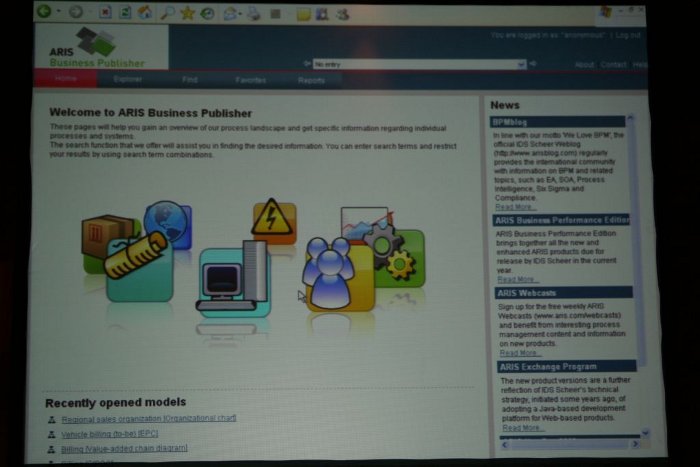I am writing live from the ARIS Product Innovation Track with the promising subtitle: Leading-Edge Concepts and Technologies for Innovative Process Management. The presentation started with a Star Wars look-alike movie. After a virtual dive from outer space into the Research laboratories of IDS Scheer, the first presentation began on the first level of the virtual laboratory.
The topic of the first agenda point was user interfaces. Helge Hess introduced the mashup technology to the audience. A mashup is integrating different types of information into one easy-to-understand, customizable interface. The key to this new generation of presentation layer are Web services. Open APIs allow open access to data sources via the Internet. This technology can be also be leveraged in enterprise applications. In the future, ARIS will also provide a mashup technology, combining process data with both additional corporate and external data.
Afterwards, Stefan Leinenbach from Interactive Software introduced the INTERACTIVE GUI for ARIS. With this, ARIS users should be able to easily model processes without knowing modeling conventions. The modeling is performed in three steps:
- Step 1: Select your virtual scenario
- Step 2: Interact as in real business
- Step 3: Get your ARIS model
A graphical interface guides the process designer through the modeling process. The user does not have to be familiar with modeling notation.
The second stop at the innovations journey brought us to level 2 in the IDS Scheer research labs. Processes for People was introduced by Britta Hilt. She is a member of the ARIS BPM Blogger Community. She spoke about the newest developments regarding ARIS Business Publisher. Together with Cogniscape, a demo of ARIS Business Publisher was presented.
Process models were presented in a nice, graphical way. The demonstrated functionality was very impressive.
On level 3 of the ARIS Research Labs, Karl Wagner spoke about process execution. His focus was on the E2E Bridge. Chris Henn from E2E showed how a model can be executed without programming with a virtual machine for the execution of EPC, BPMN and UML. UML Diagrams can directly be run without generating code. With this, the documentation is becoming the execution. Indeed an interesting approach.
On level 4 of the ARIS Research processes, we listened to a presentation by Thomas Feld about green processes. Green processes maximize efficiency, they balance ecological impact, and they ensure environmental management. For this, environmental information must be added to processes. You see an example on the picture.
The fifth level of the Labs were presented by Julia Wagner and Michael Rosemann from Queensland University of Technology. Julia Wagner illustrated the research network of IDS Scheer. She introduced different research projects which IDS Scheer is conducting in cooperation with different universities.
Michael Rosemann's presentation was introduced with the trailer of the movie "Lord of the Rings" because he presented a reference model for producing movies. The reference model can help film companies save production costs through implementing best practices models.
An interactive survey helps companies to specify their specific needs for the production. Then the related models are generated based on their production needs. I hope that I can catch Michael Rosemann during ARIS ProcessWorld. It would be great if he could write a post in the ARIS BPM Blog in which he could describe this approach a bit more in detail. @Michael Rosemann: Please leave a comment if you read this post ;-)










Site Administrator on
Marcello La Rosa said:
At the Queensland University of Techonology, we developed a framework based on the use of questionnaire interfaces to configure reference process models. For instance, a question in film production could be “What is the shooting medium to be used?”, and two possible answers of this question could be: “Tape” and “Film”. We organize the set of questions related to a given domain (e.g. film production) in a questionnaire model, in which we specify constraints and order dependencies for answering the questions, and then we link this questionnaire model to a “configurable” reference process model. The latter is basically a process model defined in an enhanced version of the EPC notation (called Configurable integrated EPC), in which possible points of variations to the standard behavior are explicitly captured. These can be variations in, e.g., the involved functions, or the human roles and business objects participating in the process. For example, in film roduction, there are a number of implications depending on the choice of Tape rather than Film as shooting medium. These implications will indeed affect the procedures followed by and the resources involved in the process. The questionnaire model is then fed into an interactive questionnaire tool, which provides contextual guidelines and advice for answering the questions. As the domain expert (e.g. a film director) answers the questionnaire to the requirements of a specific setting (e.g. for a new movie), the linked reference process model is automatically configured by discarding the process fragments that are no longer relevant, and eventually an individualized version of this process model is produced. This model can then be used for communication purposes, or better, be simulated in ARIS to evaluate the feasibility of the project.
By means of the questionnaire interface, in which configuration options are presented in terms of domain concepts, a subject-matter expert can still exploit the advantages of Business Process Management, without any knowledge of the underlying business process notation.
More details on the configuration approach can be found athttp://www.processconfiguration.com.